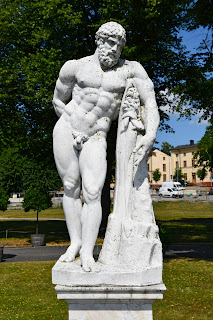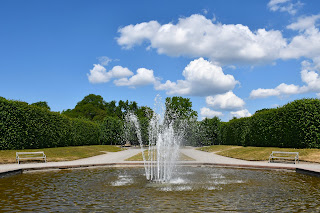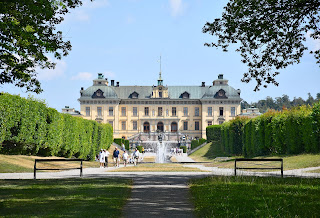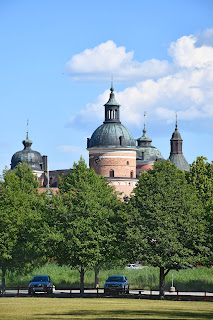Scandinavia Trip: Day 3 – Hovgården, Drottningholm, and Gripsholm
I started the day very early and not without apprehension. Having conducted plenty of research beforehand, I decided it would be possible for me to visit Hovgården, an ancient site on the island of Adelsö. Hovgården is notable for its large burial mounds, which reportedly date to the Vendel Period (500-800 CE) and the early Viking Age (800-1050 CE). An excavation of a mound dating to 900 CE found a man buried in a boat as was custom among many northern peoples (a similar discovery was made at Sutton Hoo in England).
Hovgården is also home
to the more recently crafted Hacon Stone Runestone (dated to around 1070 CE and
also referred to as U 11) and Alsnö Hus, a palace dated to 1270. The palace
is where the Ordinance of Alsnö was issued in 1279, an act that is
traditionally credited with creating Sweden’s noble class. The ordinance read
that whoever contributed a mounted soldier to the king’s cavalry would be
exempted from having to pay taxes.
Waking up at six, I
took the metro to Brommaplan, a station at the very western end of Stockholm. I
made sure to arrive early so that I could buy myself breakfast at a nearby coop
while waiting for the bus, but I did not manage to eat all of it by the time
the bus came. Throughout many moments in the day, I felt like biting into the
sweet pastry I had bought, but it was not until five o’clock that my
peckishness finally got the better of me.
The ride fell only a
little short of a true adventure. Winding our way out of civilisation, we rode
past farmsteads, forests, and fields abloom with tiny blue flowers. As opposed
to the other islands we crossed, which are connected to the mainland by
bridges, Adelsö is served by a ferry. Its schedule
seems to be tightly coordinated with the timetables of the local buses, and as
soon as we drove onto it, the ferry left. My number 312 bus arrived on time,
shortly before nine.
I did not spend long
at Hovgården despite its evident historical interest. At the end of the day, it
is not much more than a few hillocks and some ruins. I spent most of my time there
fretting that I would not find the runestone: I left the trail multiple times
to inspect rocks lying by the wayside, and when I got lazy, I took pictures of
them from afar and zoomed into them using my camera. As it turned out, the rock
was quite close to the trail between the ruins of Alsnö Hus and Adelsö Church.
Having finished quite
early, I decided I would not wait an hour and a half for the 312 bus back to
Brommaplan. Instead, I made the adventurous 30-minute trek to the ferry
terminal at Lilla Stenby. The 311 bus was scheduled to depart at 10:41 from the
opposite bank, which is the furthest west it ever goes – unlike the 312, it
never crosses over to Adelsö. Walking amidst the trees, I cursed at myself for
having worn out my feet yesterday while feeling very glad that the path mostly
went through forest, which provided shade from the sun.
I arrived in Lilla
Stenby with much time to spare – almost too much time. As I waited for the
10:30 ferry, my various anxieties over possible mishaps grew. Perhaps the ferry
would not allow pedestrians. Perhaps it would not drop me off in time for the
311 bus. Perhaps it would sink. Fortunately, none of these irrational fears
came to pass. The ferry did, in fact, have a little windowed room for
pedestrian travellers, and it even had a separate lane for their entry and exit:
it was red and narrow. And despite google maps saying that the bus would arrive
early, the driver intentionally took a little more time to allow ferry
passengers (that is to say, me) to board. The whole operation went like
clockwork.
Rather than going all
the way to Brommaplan, I rode only to Drottningholm, one of Sweden’s most
famous palaces. In fact, I had already seen it on my way to Adelsö, and it was
precisely their sharing a bus route that justified this extravagant journey in
the first place. I toured Drottningholm for perhaps two hours, starting at the
lake and walking to the Chinese pavilion before visiting the interior of the
palace. Although many of the palace views were beautiful, the central gardens
were a nightmare. Paved with gravel, they were populated by even rows of trees
that were just short enough to be completely useless in easing the heat.
With my visit coming
to a close before two o’clock (I ate a quick lunch at the Chinese Pavilion
Café), a long internal struggle broke out in my head over what to do next.
Initially, I had planned to return to Stockholm and call it a day, but another
voice full of aspirations for the person I want to be kept saying that I should
seize the day. While doing my research the night before, I forgot the name
Drottningholm and simply typed “Stockholm Palace” into Google. One of the top
results was Gripsholm, a castle I had never heard of before. Not only was it
gorgeous, but it also had two giant runestones right in front of the gate.
Eventually, I could
muster no reason why I should not visit Gripsholm, having justified my
UNESCO-list-checking trip to Adelsö with the presence of a huge runestone.
Gripsholm had two, and one of them appeared to be phrased like a traditional alliterative
poem:
Tola let ræisa stæin
þennsa at sun sinn Harald, broður Ingvars.
Þæir foru drængila fiarri at gulli
ok austarla ærni gafu,
dou sunnarla a Særklandi.
A rough translation of
the rune would be: “Tóla had this stone raised in memory of her son Haraldr,
Ingvarr’s brother. They travelled valiantly far for gold, and in the east gave
(food) to the eagle. (They) died in the south in Serkland.”
The train to Läggesta
(from which Gripsholm is reachable by several buses) was delayed by what turned
out to be half an hour, which gave me just enough time to figure out that I
could not buy tickets for it through any of the apps I had downloaded, and to
download the necessary platform. It meant that I would arrive at Gripsholm long
after closing hours, but I did not anticipate I would make it on time either
way and was content to take pictures of the castle from afar.
How great was my
disappointment, therefore, when I found out that the best lakeside views of the
castle are from the private property of some very wealthy entity. I briefly
considered pretending to lose my way into it, but instead decided to enter the
nearby Deer Field Nature Preserve. After wandering about a little, I realised
there might be a good view from the rocky hill at its very northern tip. This
deduction was the blow that hit the jackpot.
Once I had taken enough pictures and climbed down again, I inspected the two runestones and returned to Stockholm. My research on the runes, however, also happened to churn up one interesting fact: hidden in the middle of the old town in Stockholm is a runestone I had completely missed. It was built into the walls of a house at an intersection not far away from the Great Church, and I had simply never walked down that road despite criss-crossing the city on the previous day. My last stop for the day, therefore, was the U 53 in Stockholm, a piece with intertwining runes and what appears to be the body of a snake.






























































Comments
Post a Comment